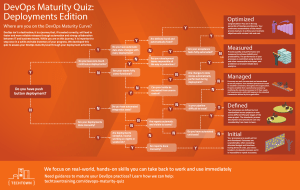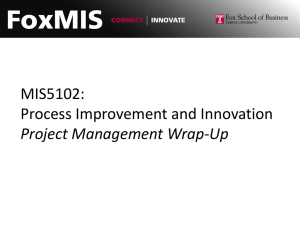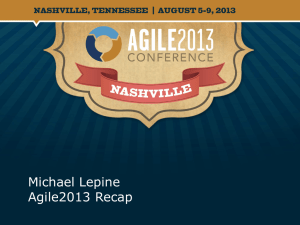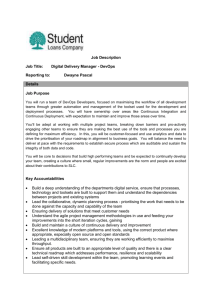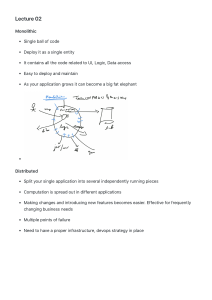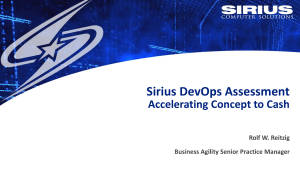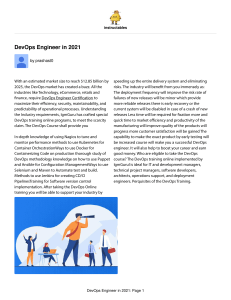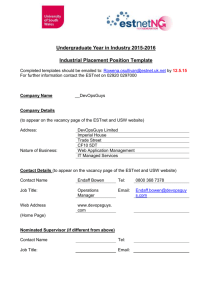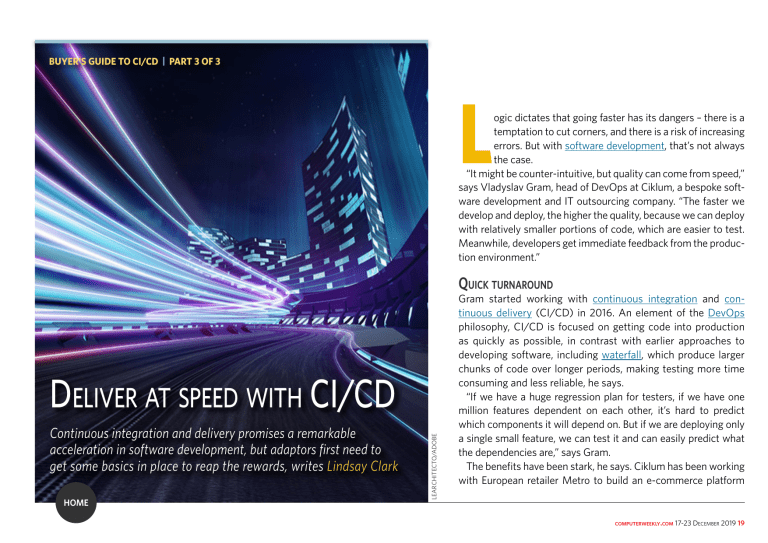
BUYER’S GUIDE TO CI/CD | PART 3 OF 3 L ogic dictates that going faster has its dangers – there is a temptation to cut corners, and there is a risk of increasing errors. But with software development, that’s not always the case. “It might be counter-intuitive, but quality can come from speed,” says Vladyslav Gram, head of DevOps at Ciklum, a bespoke software development and IT outsourcing company. “The faster we develop and deploy, the higher the quality, because we can deploy with relatively smaller portions of code, which are easier to test. Meanwhile, developers get immediate feedback from the production environment.” Quick turnaround Continuous integration and delivery promises a remarkable acceleration in software development, but adaptors first need to get some basics in place to reap the rewards, writes Lindsay Clark HOME LEARCHITECTO/ADOBE Deliver at speed with CI/CD Gram started working with continuous integration and continuous delivery (CI/CD) in 2016. An element of the DevOps philosophy, CI/CD is focused on getting code into production as quickly as possible, in contrast with earlier approaches to developing software, including waterfall, which produce larger chunks of code over longer periods, making testing more time consuming and less reliable, he says. “If we have a huge regression plan for testers, if we have one million features dependent on each other, it’s hard to predict which components it will depend on. But if we are deploying only a single small feature, we can test it and can easily predict what the dependencies are,” says Gram. The benefits have been stark, he says. Ciklum has been working with European retailer Metro to build an e-commerce platform computerweekly.com 17-23 December 2019 19 BUYER’S GUIDE Home News Post Office will pay £57.75m damages to settle dispute with subpostmasters How Intel processor delays are putting the brakes on Windows 10 migrations Association of Tennis Professionals serves tech from all angles Technology is lifeblood for emergency response by London Ambulance Service Editor’s comment Buyer’s guide to CI/CD What EU’s decision on Facebook means for social media Is artificial intelligence failing to live up to the hype for enterprises? Downtime and has cut the standard three-month deployment release schedule to one hour to get changes to production. “The difference is huge, but that doesn’t mean we are deploying the same amount of changes every hour that we would release in three months. However, it does mean the developer gets feedback from users and the production environment much faster than on a three-month release schedule,” he says. to poor performers, the former achieved 208 times more frequent code deployments, 106 times faster lead time from committing code to deployment and 2,604 times faster to recover from incidents. Race to cloud Although they are related, DevOps and CI/CD should not be confused, says Ariane Gadd, Features delivered faster lead DevOps engineer at KPMG. Jez Humble, a lecturer at University “DevOps is more of a culture, a is the ability to of California, Berkeley, and mindset, and a way of working. co-founder of DevOps Research CI/CD is an approach to orchesget changes of all types and Assessment (Dora), literally tration led by tooling and automanew features configuration wrote the book on CI/CD in 2010. tion. Organisations use CI/CD to He defines it as: “…the ability to get implement technology projects in changes bug fixes experiments changes of all types – including new a DevOps kind of way. You can’t do features, configuration changes, DevOps without CI/CD.” into production or into the bug fixes and experiments – into The rise of CI/CD coincides with production, or into the hands of the increasing popularity of deployhands of users safely and users, safely and quickly in a susment in the cloud. Although organiquickly in a sustainable way tainable way.” sations could use conventional According to a survey by software development techniques to build Jez Humble, Dora testing firm Mabl, 53% of the 500 software for the cloud, there would respondents use continuous intebe little point, says Gadd. gration and 25% plan to introduce it. Meanwhile, 38% of respond“You’re not really getting the benefits of the cloud if you are ents employ continuous delivery and 30% plan to do so. deploying software as you would on-premise. [With CI/CD] you The 2019 Accelerate state of devops report, for which Dora surget cloud-native things like optimisation, scalability and elasticveyed 3,000 developers, found that, comparing the elite group ity, and performance. If you don’t leverage those, you’ve just got “[CI/CD ] – , – , , , , ” computerweekly.com 17-23 December 2019 20 BUYER’S GUIDE Home News Post Office will pay £57.75m damages to settle dispute with subpostmasters an on-premise solution in the cloud and you are not really leveraging the benefits,” she says. Culture must turn a corner Technology is lifeblood for emergency response by London Ambulance Service One of the difficulties in introducing CI/CD is changing people’s roles as new tools are deployed. Security controls and change approvals were once manual processes, with a person allocated to them. With CI/CD they are automated. “It is not necessarily telling people we are going to automate you out of a job, but it is saying, ‘Let’s change the way we work’. The trickiest thing is getting all the teams working together so they understand they will not see the process as they have done in the past and they are not going to go through the change board every time they want to implement a change. It is still secure and in line with policy, but it is a question of getting everyone on board, and educating them in the new way of doing things,” says Gadd. Editor’s comment Start slow, build from there How Intel processor delays are putting the brakes on Windows 10 migrations Association of Tennis Professionals serves tech from all angles Buyer’s guide to CI/CD What EU’s decision on Facebook means for social media Is artificial intelligence failing to live up to the hype for enterprises? Downtime The introduction of CI/CD has not been flawless. For example, half of organisations doing so do not include any security testing elements, according to a 451 Research survey of 350 enterprise IT decision-makers in North America and Europe fielded in May 2018. Problems can occur when development teams confuse the speed of delivery with a lack of preparation, says Gadd. “The mistake a lot of people make is they think it is all about building quickly and delivering fast, but they forget to document properly, so nobody knows what they have actually done,” she says. Top three pitfalls to avoid when introducing CI/CD Continuous integration (CI) and continuous delivery (CD) can enable faster iterations, faster time to value for customers, services isolation for debugging, and root-cause analysis, says Shiven Ramji, chief product officer of Auth0, developer of an enterprise identity platform. But he also offers lessons in avoiding pitfalls. His top three recommendations are: n S eparation of services. It is critical that you break apart your monolithic app into separate services such that they are isolated and abstracted from each other. n B efore you get to CD, make sure you do CI well. There are some foundational elements such as having consistent tooling, libraries and operating system configurations. n M any organisations have tooling sprawl in an effort to get CI/CD right. Make sure you invest in the underlying infrastructure, the correct tooling and have the right metrics in place. computerweekly.com 17-23 December 2019 21 BUYER’S GUIDE Home News Post Office will pay £57.75m damages to settle dispute with subpostmasters How Intel processor delays are putting the brakes on Windows 10 migrations Association of Tennis Professionals serves tech from all angles Technology is lifeblood for emergency response by London Ambulance Service Editor’s comment Buyer’s guide to CI/CD What EU’s decision on Facebook means for social media Is artificial intelligence failing to live up to the hype for enterprises? Downtime Gadd recommends investing time upfront in optimising infrastructure and developing the correct scripting. Otherwise teams will have to go back and make changes retrospectively, losing benefits and damaging the reputation of the approach they are trying to promote. “It takes time at the beginning to automate things and write scripts. But once you’ve got that right, you can repeat it as many times as you want,” she says. and move up to the next level,” he says. “Teams that go too fast before they are ready just break things faster, and they don’t get fixed. It’s definitely about going as fast as you can, but no faster. That’s the biggest lesson I’ve learned.” The right tools As teams’ understanding of CI/CD improves, so does the tooling. This ranges from generalist collaboration software such as eams that go too fast Curb your speed Slack, to technical tools such as Cytora has developed a technology Pivotal Concourse, which helps before they are ready just break platform to help insurance comdeveloper teams design workflow panies underwrite their policies for modular components. things faster and they don t more accurately. Don Tran, director For all its increase in popularity, of engineering, began introducing CI/CD has a long way to go before get fixed t s definitely about CI/CD about a year ago. it becomes the de facto method of going as fast as you can but He says the greatest lesson is that software development, says Tran. it is not all about speed. “When I “Software developers are convergno faster hat s the biggest started, I thought it was about going ing to using a lot of the things that super-fast, just unlocking the speed. come out of continuous delivery. But lesson ve learned But it is actually way more imporenterprise IT is all-encompassing D on Tran, Cytora tant to go as fast as you can right and pretty big, and this concept is now, but no faster,” he says. still very new. It’s early days.” Different development teams will rely on different infrastrucCI/CD promises a phenomenal acceleration of software develture, tooling and be at a different stage in their DevOps journey. opment speed compared with traditional methods of building If a team gets the cycle down from two weeks to one week, they software. But teams considering the approach must educate should see that as progress, says Tran. “If that’s as fast as you can developers, change the culture among the wider IT teams, and go right there and then, then good, but you can iterate on that invest in tooling and infrastructure to reap the benefits. n “T .I ’ .T I’ , ’ , ’ ” computerweekly.com 17-23 December 2019 22 Copyright of Computer Weekly is the property of TechTarget, Inc. and its content may not be copied or emailed to multiple sites or posted to a listserv without the copyright holder's express written permission. However, users may print, download, or email articles for individual use.

